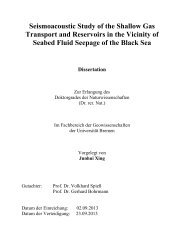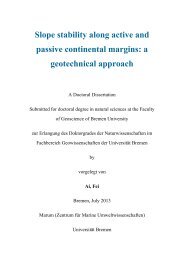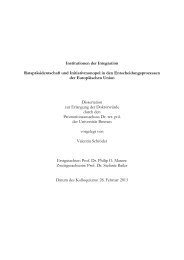aus dem MARUM und dem Fachbereich Geowissenschaften der ...
aus dem MARUM und dem Fachbereich Geowissenschaften der ...
aus dem MARUM und dem Fachbereich Geowissenschaften der ...
Create successful ePaper yourself
Turn your PDF publications into a flip-book with our unique Google optimized e-Paper software.
MARIA S. MERIAN-Berichte, Cruise 20, Leg 4, Bridgetown – Freeport, 15.3.2012 – 7.4.2012<br />
5.2.2 USBL POSIDONIA<br />
IXSEA’s POSIDONIA 6000 is an ultra-short baseline (USBL) <strong>und</strong>erwater navigation that was<br />
used during ROV dives and for one of the box corer stations. The moon-pool mounted antennas<br />
require a calibration and a proper SVP. Most recent calibrations for the system were done in<br />
2009 (MSM13-4) and 2010 (MSM15-2). Although the SEAPATH 200 is delivering DGPS and<br />
motion sensor data, just GPS-information is used for the USBL bec<strong>aus</strong>e POSIDONIA 6000 has<br />
its own motion sensor. The motion sensor, IXSEAS OCTANS in a wet pot, is mounted directly<br />
above the four antennas. SVP has been updated for every area of investigation or whenever<br />
changes in surface so<strong>und</strong> velocity appear to be higher than 3 m s -1 (see Appendix 1 for settings<br />
of POSIDONIA during MSM 20-4).<br />
5.2.3 Multibeam Echoso<strong>und</strong>er (MBES)<br />
Seabed mapping during MSM20-4 was performed with two devices, the ship’s hull-mounted<br />
KONGSBERG EM120 deep-water MBES (12kHz) and the moon-pool mounted KONGSBERG<br />
EM1002 that is a shallow- to medium-water MBES (95kHz). The EM120 has a depth range of<br />
20 to 11,000 m, while the depth range of the EM1002 is 2 to 1,000 m but achieves a much higher<br />
depth resolution of 2-8 cm, depending on the pulse lengths (0.2-2 ms).<br />
On R/V MARIA S. MERIAN, the EM120's footprint of a single beam is limited to 2° by 2°.<br />
The angular coverage sector is up to 150°. EM120 has 191 beams per ping, while the EM1002<br />
has 111 beams per ping. Achievable swath width on a flat bottom is up to 5 times the water<br />
depth dependent on the character of the seafloor. The angular coverage sector and beam pointing<br />
angles are set to vary automatically with depth according to achievable coverage. This<br />
maximizes the number of usable beams. The beam spacing is equidistant to equiangular. All<br />
settings applied for the two MBES systems during MSM 20-4 are listed in Appendix 1. For<br />
reasonable hydroacoustic recording a proper SVP is essential. Thus, several CTD’s were taken<br />
during the cruise (see Chapter 5.3). In every survey region at least 1-2 SVP’s were calculated<br />
based on the SEABIRD CTD measurements (Fig. 5.2). The SVPs have been applied to EM120<br />
and EM1002 right after the data were collected. The SVPs show a wide variability over the<br />
entire water column, documenting that the precision of the seabed bathymetry map relies on a<br />
SVP in each survey area.<br />
Fig. 5.2<br />
So<strong>und</strong> velocity profiles (SVP) calculated from CTD data.<br />
11

















